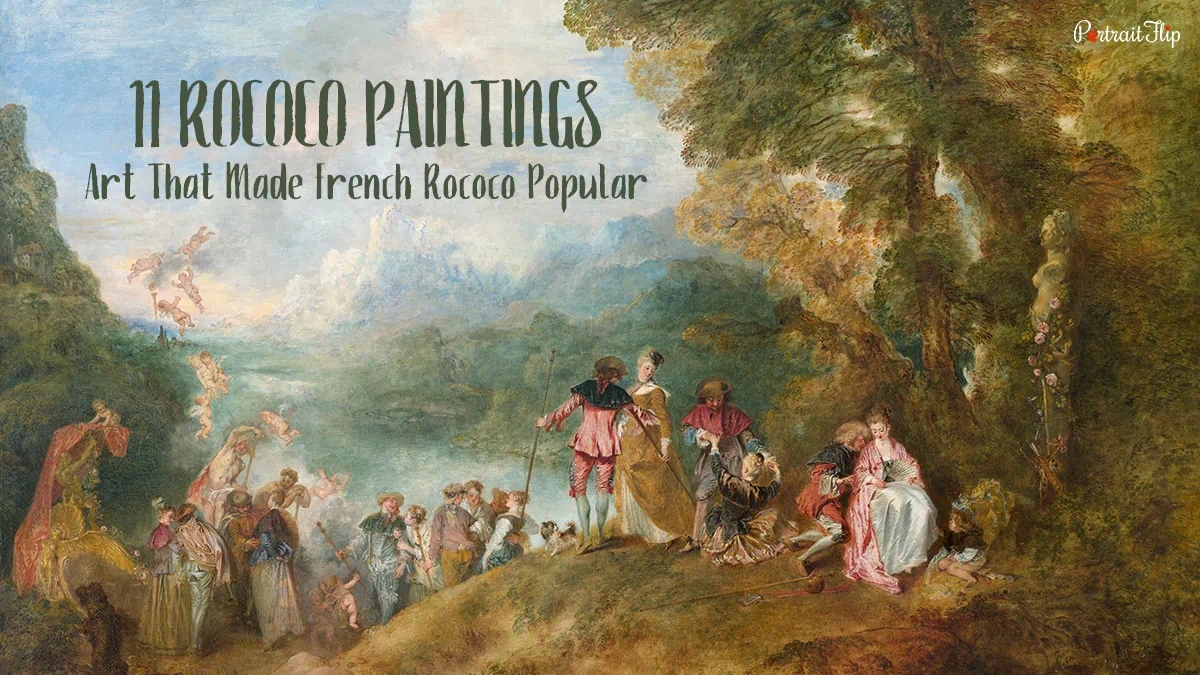Countless pieces of rococo art were made. Some touched the doors of renowned galleries and museums, while others remained an heirloom of art patrons.
Before I present to you the most popular rococo paintings, let me give you a brief explanation of how it all started.
Let’s learn what happened in European art in the 18th century—when French elites shifted to their private homes away from royal palaces in Versailles.
The drastic step was a result of the fall of King Louis XIV’s reign, which gave rise to a new artistic expression called Rococo.
Rococo art was nothing but a reaction against the heavy, formal style of Baroque art—which entailed religious and political scenes and subjects.
In simple terms, it was an extended branch of Baroque art with different leaves—that means it has distinctive artistic approaches, mindsets, and ideas compared with its former movement.
Rococo art was only about pleasure, fun, and leisure. Initially, it dealt with decorating churches—basically, focusing on interior design styles.
But in a short span, it extended its arm, meaning it moved to painting from fresco and sculpture.
And pivoted its focus on satire, domesticity, religion, and sensuality, which was, with open hands, welcomed by the upper class.
That’s when the era began, when several rococo painters came out and produced the finest rococo paintings.
The artwork from Rococo was so enchanting that it required a little time to flourish across the country.
And in a span of a few years, it even cemented its position in different parts of Europe, mainly Germany, Austria, and England.
Rococo’s history was as diverse and vast as I described it above, and this blog will show which famous paintings of Rococo were created and why!
(Also Read: 8 Famous Neoclassical Paintings)
Table of contents
- 1. The Embarkation for Cythera by Jean-Antoine Watteau
- 2. Soap Bubbles by Jean Siméon Chardin
- 3. Triumph of Venus by Francoise Boucher
- 4. The Entrance to the Grand Canal by Canaletto
- 5. La Toilette de Vénus by François Boucher
- 6. Allegory of the Planets and Continents by Giovanni Battista Tiepolo
- 7. Portrait of Madame de Pompadour by François Boucher
- 8. The Bathers by Jean-Honoré Fragonard
- 9. The Swing by Jean-Honoré Fragonard
- 10. The Blue Boy by Thomas Gainsborough
- 11. Pierrot by Jean-Antoine Watteau
- Final Note
- Frequently Asked Questions
1. The Embarkation for Cythera by Jean-Antoine Watteau
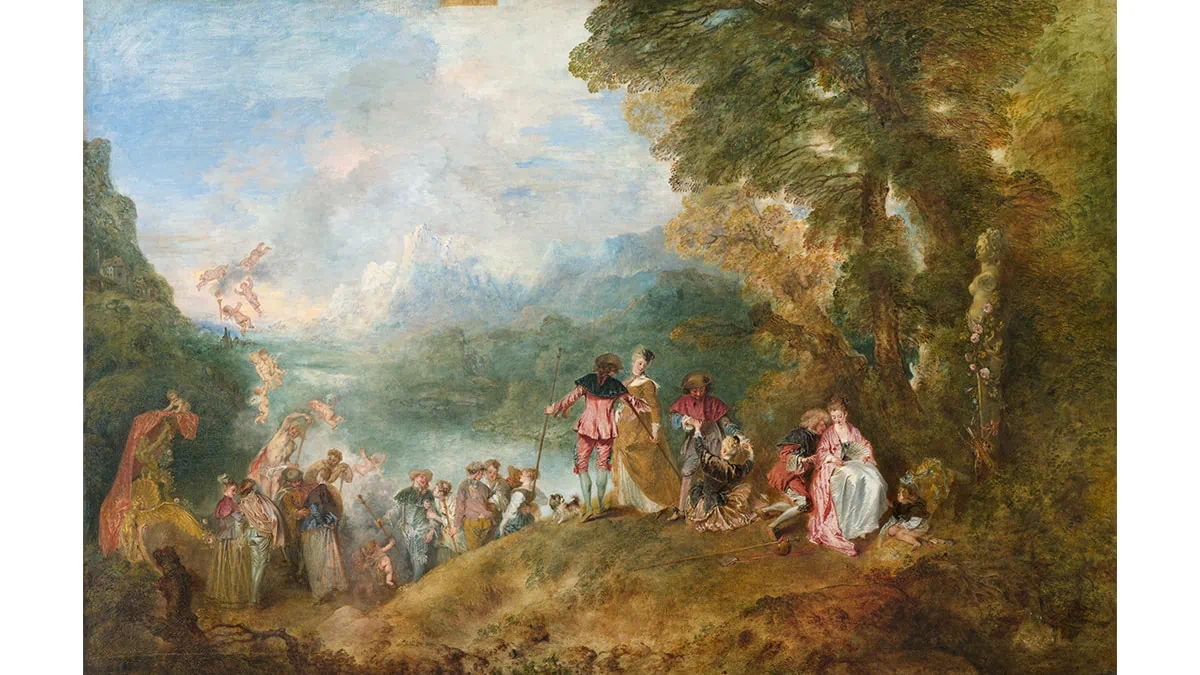
This Rococo art by Watteau is truly magical; guess what? It was the most expensive Rococo painting by the artist.
The art is widely known as Pilgrims to Cythera; “Cythera” is an island in Greece that is believed to be the birthplace of Goddess Aphrodite.
The French artist left several connotations on the composition, signifying love and oneness; one could learn the fact by observing the couples standing under the tree.
There’s a strong intimacy—a feeling of oneness and admiration among them, which you could guess by the way they were shown.
On the left, there’s a prow that is partially draped by red silk cloth, and next to it are oarsmen on the boat, who are seen as angels who apparently have arrived to pick or leave this couple on Cythera.
Watteau was an avid watcher of operas and religious plays; perhaps that drove him to create this rococo artwork.
The catch is that it was a reception piece that Watteau created to get himself included in the Royal Academy of Art.
| Painting Name | The Embarkation for Cythera |
| Creator | Jean-Antoine Watteau |
| Medium | Oil on canvas |
| Date Painted | 1717 |
| Dimensions | 129 cm x 194 cm |
| Where It Is Currently Housed | Musée du Louvre, Paris, France |
2. Soap Bubbles by Jean Siméon Chardin
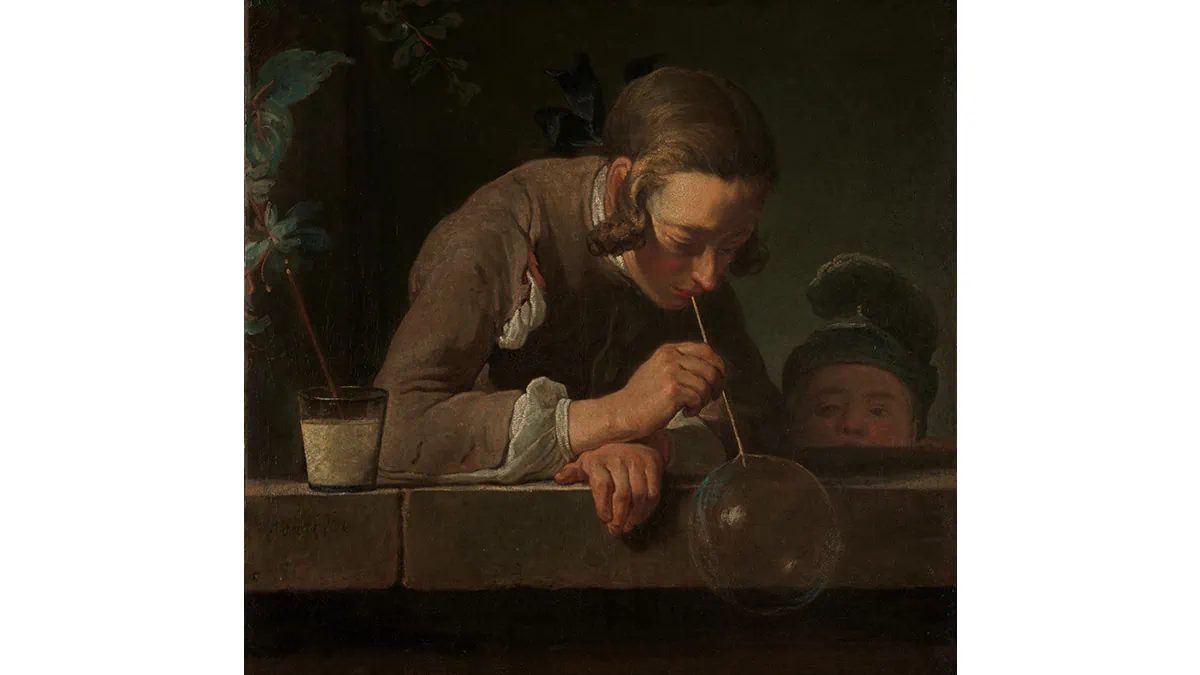
If you flip the pages of any history book related to European art, you’ll notice that symbolism exists in almost every piece of art, but not every piece of art.
That means some had a very casual theme; speaking of which, Soap Bubble, a famous rococo artwork, is the epitome of casual and pastime.
Despite not having an extraordinary subject matter or entailing an innovative painting approach, Soap Bubble made it to this list.
Why? Because if take a look at it, you’ll see an extra layer of brown covering the entire canvas, as if it were responsible for muting the tone and color of this rococo composition.
A young boy was featured blowing a bubble, and a boy behind him is shown secretly looking at his innocent deed.
Quite casual in nature, Chardin’s art was stuck with what rococo was all about, i.e., restricting the notions of baroque and focusing on domestic scenes.
By depicting everyday scenes of the French middle class, Chardin garnered immeasurable attention, and his reach even met that of famous painters like Vincent Van Gogh, Paul Cezanne, and Edouard Manet.
| Painting Name | Soap Bubbles |
| Creator | Jean Siméon Chardin |
| Medium | Oil on canvas |
| Date Painted | 1733 – 1734 |
| Dimensions | 61 cm x 63.2 cm |
| Where It Is Currently Housed | Metropolitan Museum of Art, New York City, United States |
(Suggested: The Card Players Artwork)
3. Triumph of Venus by Francoise Boucher

Bold and beautiful could be an understatement if I had to describe this famous rococo painting.
This wasn’t the first time Goddess Venus was featured in art; there are a handful of famous nude artworks that demonstrate Venus in a different environment.
Triumph of Venus is Francois Boucher’s most recognized work, which features mythological characters in a well-balanced yet active position.
The art showcases what rococo was, and it vividly defines what the painter is capable of.
The goddess of love appears out of foam, and she was brought to an island called Cythere by Seo Nymphs.
The emphasis of art is its eroticism and drama, featuring other subjects, including Naked Tritons (male sea nymphs) and Naiads (female dittos).
This rococo painting became so popular at its time that it was transformed into prints, porcelain figurines, and tapestries, setting high standards for aspirants.
| Painting Name | Triumph of Venus |
| Creator | Francoise Boucher |
| Medium | Oil on canvas |
| Date Painted | 1740 |
| Dimensions | 130 cm × 162 cm |
| Where It Is Currently Housed | National museum, Stockholm |
4. The Entrance to the Grand Canal by Canaletto
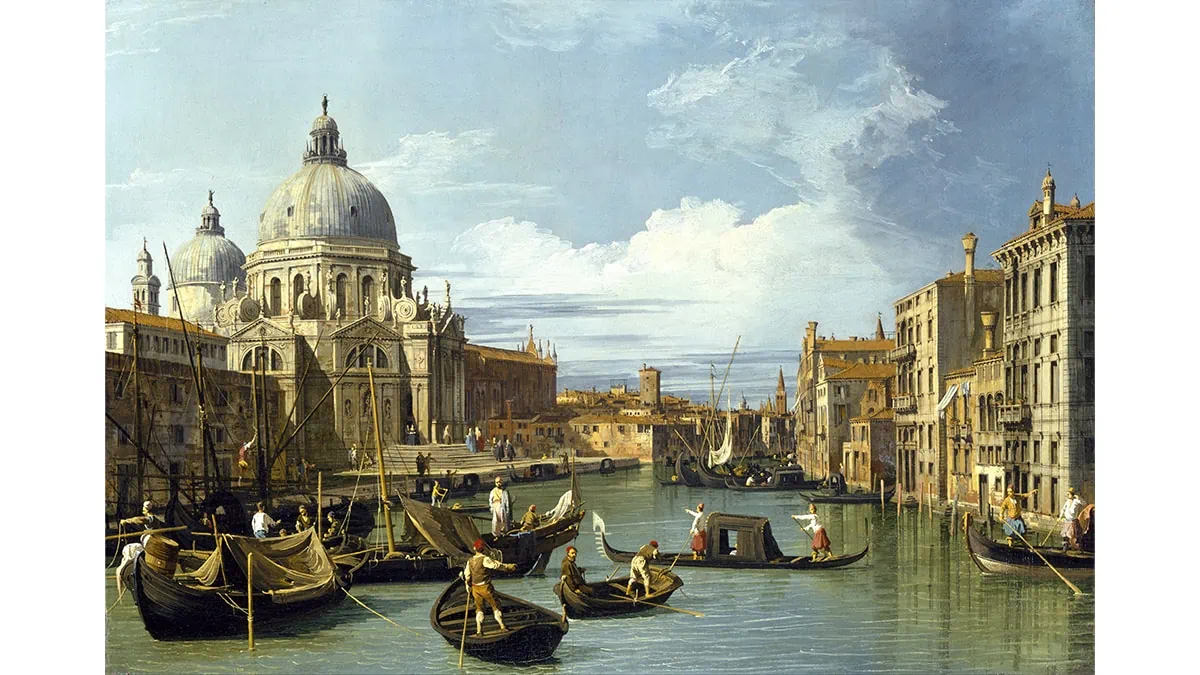
The Entrance to the Grand Canal is Canaletto’s most popular rococo landscape painting.
Featuring locals in boats flocking to the canal under the beautiful noon sky, Canaletto’s art leaves a serene and positive vibe.
The entrance takes you nowhere but Venice, which back then was a hub for artists.
Domestication was its theme, and with the asymmetrical design, this rococo theme art left an indelible mark on aesthetes of that point.
This famous rococo painting has grabbed several accolades—thanks to Canaletto, who always admired nature and art and put his soul and heart into something that made his craft better.
The way natural lights thrash on every subject and the way colors are used make every part—whether it is the church, passengers, or buildings on the right—luminous and attractive.
| Painting Name | The Entrance to the Grand Canal |
| Creator | Canaletto |
| Medium | Oil on canvas |
| Date Painted | 1730 |
| Dimensions | 49.6 cm × 73.6 cm |
| Where It Is Currently Housed | Museum of Fine Arts, Houston, Houston |
5. La Toilette de Vénus by François Boucher

Another classic by Francois Boucher is “La Toilette de Venus”, an artwork commissioned for him by Madame de Pompadour.
You could see the goddess of love and beauty being featured in art this time, however, to decorate the patron’s luxurious three-room suite.
Along with her are three cherubs and two doves, one of which is held by the goddess herself, and the other stands next to her legs.
Cherubs are shown engrossed in their activities; the first, who is lying on the couch on his chest, is playing with the jewelry.
The second was tying an accessory in Venus’s hair. While the last cherub is shown distracting her—who was posing, looking at the first cherub—by grabbing the wings of the dove.
The rococo painter knew how to capture viewers’ gaze, which he did spectacularly in this art by demonstrating Venus, which always served as a prime subject in 18th-century art.
| Painting Name | La Toilette de Vénus |
| Creator | François Boucher |
| Medium | Oil on canvas |
| Date Painted | 1751 |
| Dimensions | 108.3 cm x 85.1 cm |
| Where It Is Currently Housed | The Metropolitan Museum of Art, New York, United States |
6. Allegory of the Planets and Continents by Giovanni Battista Tiepolo
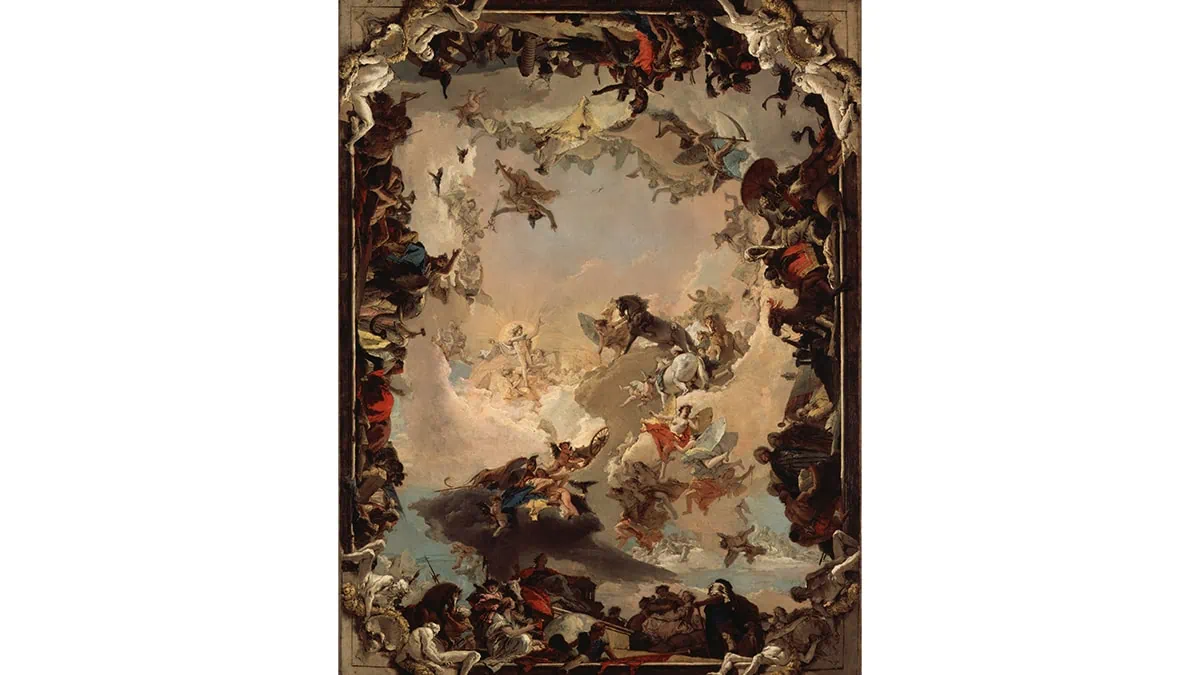
Tiepolo’s rococo artwork is not just art but an experience that demonstrates ancient narratives and sacred characters.
The reason behind the success of this rococo painting is its representation of fictional characters with an exceptional use of colors and lights.
After accepting the proposal of Carl Philipp von Greiffenklau, Tiepolo made sure that he’d make the best use of his time. Because this art was going to be Carl’s property and would be used to adorn the ceiling of his staircase.
Whoever would take the staircase would take a pause and keep their gaze on it.
The rococo artist demonstrated many figures pointing towards the center, as if it were the spot from which magical energy flew out.
The cosmic theme of rococo art shows Apollo embarking on his new journey, with deities being around the God Sun, representing the planets, and allegory figures personifying Africa, the Americas, Asia, and Europe.
| Painting Name | Allegory of the Planets and Continents |
| Creator | Giovanni Battista Tiepolo |
| Medium | Oil on canvas |
| Date Painted | 1752 |
| Dimensions | 185.4 cm x 139.4 cm |
| Where It Is Currently Housed | Metropolitan Museum of Art, New York, United States |
(Also Read: Ancient Greek Paintings)
7. Portrait of Madame de Pompadour by François Boucher

The famous rococo painting is as mesmerizing as the subject in real life was.
Francois’s rococo art featured Madame de Pompadour, who remained influential for almost two decades in France.
The art seems a little busy, as it’s bombarded with several elements, such as the lyre watch above the bookcase, which too is loaded with books, some lying around the lady.
Almost half of the composition is dominated by the lady and her beautiful floral dress, which is the highlighting/ emphasis in art.
Though reality was different, the artist portrayed a lady who, in reality, held a significant position that no other woman of her time ever did at the French Royal Court.
Femininity is at its peak; the gaze of the lady, holding a book and wearing a long, loose, floral gown, represents the power and position she held during the 1745 French royal court.
The specialty of Rococo’s portrait art is its elegance. Which never approves lies, hoaxes, and unreasonableness but entails purity and depth.
| Painting Name | Portrait of Madame de Pompadour |
| Creator | François Boucher |
| Medium | Oil on canvas |
| Date Painted | 1756 |
| Dimensions | 212 cm x 164 cm |
| Where It Is Currently Housed | Alte Pinakothek, Munich, Germany |
8. The Bathers by Jean-Honoré Fragonard

Ever since the movement came to light, many pieces of art have been crafted, including The Bathers by Fragonard, which is, to this day, considered the most famous painting of Rococo.
Its nudity theme didn’t raise eyebrows but received praise all across France, featuring eight women bathing in the daylight.
The rococo art is a blend of landscape and realism and demonstrates eight women in different positions over the bushes on the left side.
Fragonard was fond of fun, nature, and happiness, which drove him to produce this rococo art, documenting the decadence of the time.
The artist’s distinctive style and approach made him stand out from others who, too, helped Rococo progress throughout the 18th century.
The Bathers expresses the gentleness and innocence of women, which received immense appreciation, and has also set high standards for those who wanted to imitate Fragonard’s rococo art.
| Painting Name | The Bathers |
| Creator | Jean-Honoré Fragonard |
| Medium | Oil on canvas |
| Date Painted | 1765 |
| Dimensions | 80 cm x 64 cm |
| Where It Is Currently Housed | Musée du Louvre, Paris, France |
9. The Swing by Jean-Honoré Fragonard
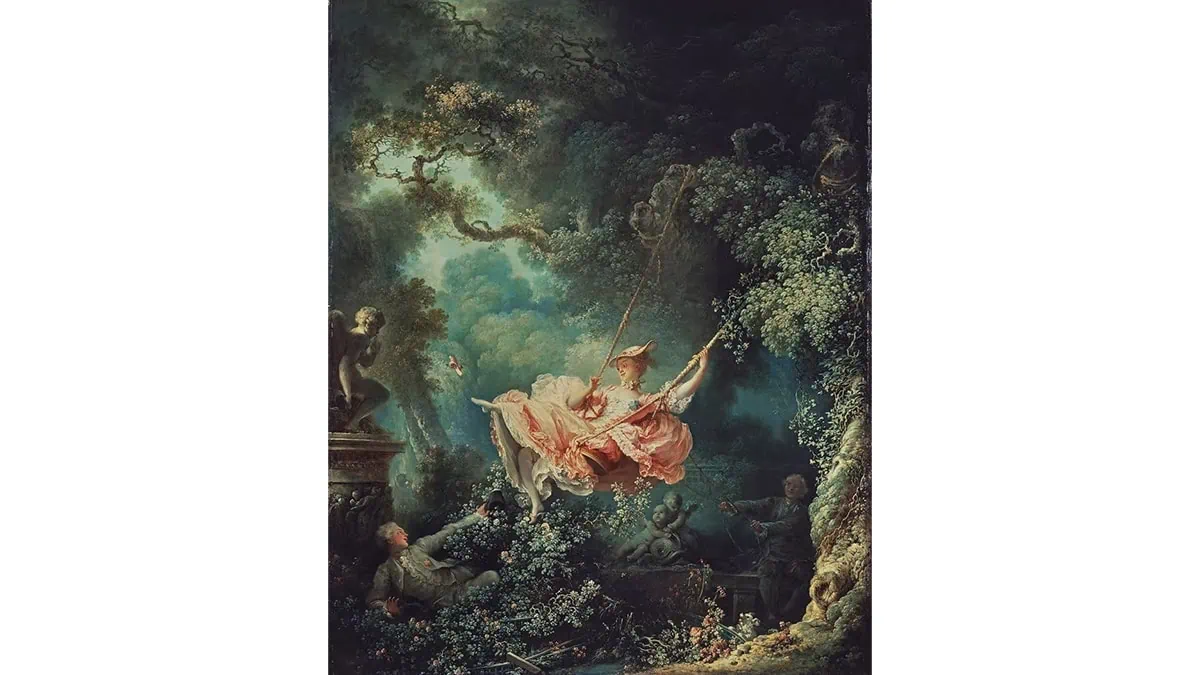
The Swing is a visual treat for viewers that exemplifies the rococo style.
Fragonard’s rococo-style painting is as poetic as he was; it evidently demonstrated his admiration for fiction, nature, and of course, fun.
The lady wearing a conical Asian hat is amusingly swinging from the branch of a tree. She is surrounded by a man below her in the lushness and a man behind the shadow, who is shown pulling the rope of the swing.
This 18th-century rococo art features characters that hold a resounding relevance, but the way colors, lights, and brush strokes are used adds an extra layer of elegance, which is what the rococo artist was known for.
Fragonard was commissioned for The Swing by Baron Louis-Guillaume Baillet de Saint-Julien.
The fun fact is that Fragonard wasn’t his first preference; it was a history painter, Gabriel François Doyen.
However, considering the nature of the work and his own intentions, Baron assigned this work to Fragonard, and he, inarguably, did a fantastic job.
| Painting Name | The Swing |
| Creator | Jean-Honoré Fragonard |
| Medium | Oil on canvas |
| Date Painted | 1767 |
| Dimensions | 81 cm x 64.2 cm |
| Where It Is Currently Housed | Wallace Collection, London, United Kingdom |
10. The Blue Boy by Thomas Gainsborough
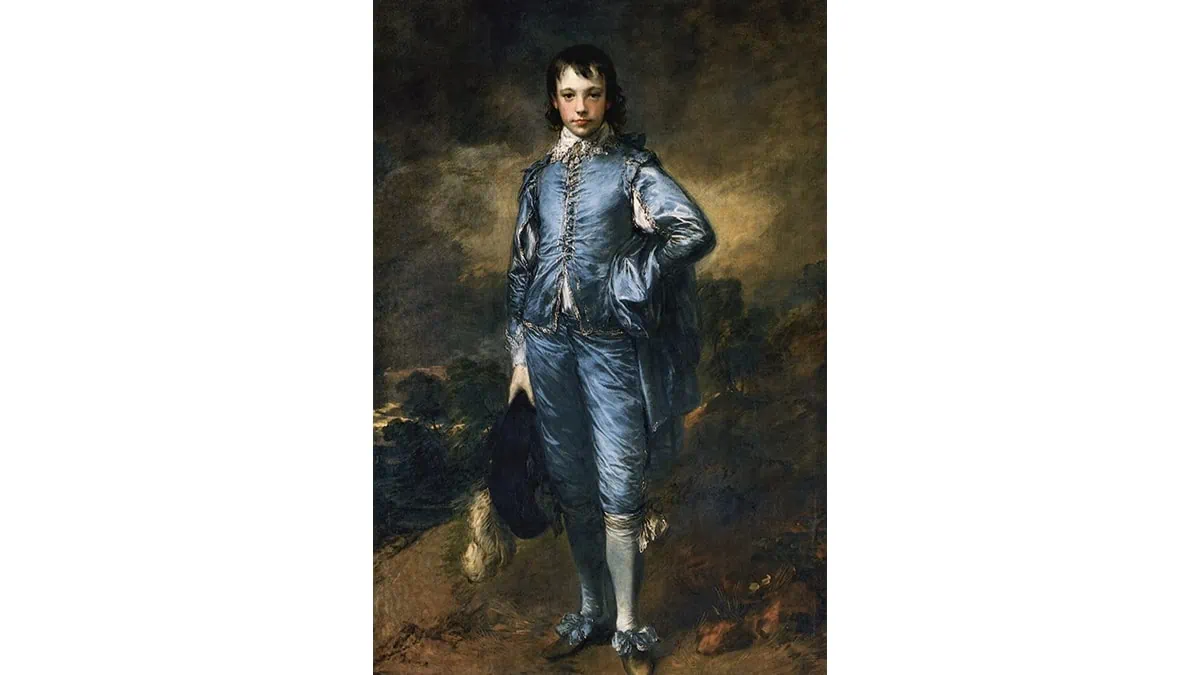
Thomas Gainborough’s The Blue Boy is Rococo’s most recognizable painting.
Its background, artistic approach, and painter—who spent months conceptualizing and composing—will tell you why.
Speaking of its composition, the rococo portrait features a boy in azure clothing, looking spectacularly elegant and viewing us straight, with one holding a hat and the other resting above the hip, forming some space in between.
It’s one of the most successful rococo paintings that challenged the notion of restricting blue as a primary color in artwork.
Gainsborough, being adamant, used blue as the primary color, which back then was preferred only for backgrounds.
The artist was the pupil of renowned French artist Hubert Gravelot, and this rococo art, which he made, received immense and immediate recognition and was seen as the first successful English rococo painting.
There’s a use of various bright and happening colors, which you wouldn’t find in any other rococo artworks.
Reflecting the traditions of rococo style, The Blue Boy also incorporates the innovative features of realism, evident by its tightly laced buttons.
| Painting Name | The Blue Boy |
| Creator | Thomas Gainsborough |
| Medium | Oil on canvas |
| Date Painted | 1770 |
| Dimensions | 177.8 cm x 112.1 cm |
| Where It Is Currently Housed | Henry E. Huntington Art Gallery, San Marino, California, United States |
11. Pierrot by Jean-Antoine Watteau
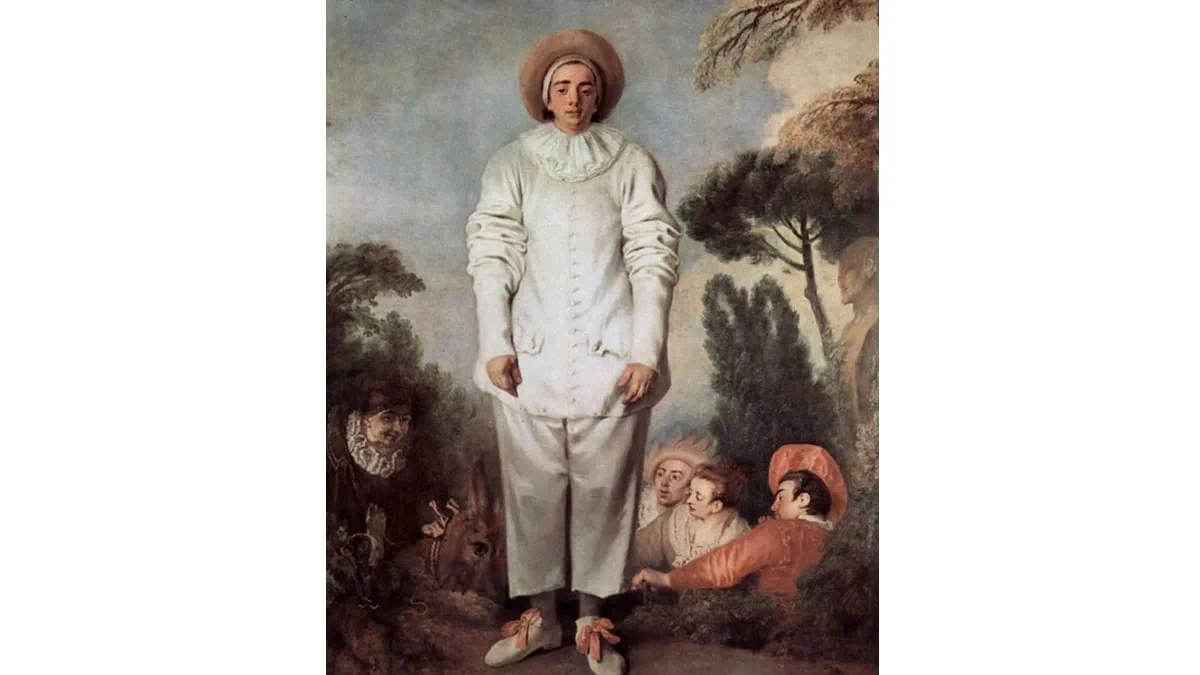
The human-sized portrait from the Rococo period showed the two sides of life. The one that we see and the other that actually exists
Painted between 1718 and 1719, the rococo art represents a comedian in costume.
He’s enveloped by four people with their gazes on his shoes.
The comedian, who, from top to toe, dressed elegantly, seemed like a person hiding his melancholy.
His expression may hurt you, or perhaps infuriate you, because seeing someone do something he/she doesn’t like is a painful sight to witness.
The artist flawlessly worked on colors, lights, and the composition, as nobody would leave without noticing the emotion if he/she paid attention to the subject.
For some, the expressions remained questionable, but you could guess that there’s a melancholy tone, considering the arms on the sides and the shadow covering his right eye.
Pierrot exemplifies finesse. If you didn’t know, Watteau’s art was made during the last phase of his artistic career, when he was about to resign because of his deteriorating health.
| Painting Name | Pierrot |
| Creator | Jean-Antoine Watteau |
| Medium | Oil on canvas |
| Date Painted | 1718-1719 |
| Dimensions | 184.5 cm × 149.5 cm |
| Where It Is Currently Housed | Musée du Louvre, Paris, France |
(Also Read: Brief History of Chinese Art)
Final Note
At the very start, rococo was only into interior design; churches, monuments, and religious infrastructure reaped the benefit of it.
Slowly, it pivoted to paintings—that’s when the masses learned about it—and with their full potential, they promoted it across France.
The above-picked rococo paintings explain a lot about the artists and the mindset they carried while working on them.
Most of them made it to top museums, galleries, and abodes of elites, while others found their spots in private collections.
If I had to describe these rococo paintings in three words, I’d say: elegant, enigmatic, and enthralling.
Frequently Asked Questions
Jean-Antoine Watteau was a key figure in Rococo art and was also the founder of the movement.
The Swing, The Blue, Pierrot, and The Embarkation for Cythera are some of the best examples of Rococo art.
The Goddess Venus, mountains, lushness, and aristocrats are some of the common subjects of rococo paintings.
Baroque art was more about religious sentiments and scenes, whereas rococo, which had its roots in Baroque, mainly covered leisure, domestication, and the power and position of French aristocrats.
As long as art entails lighter tones, casual depictions of mythological characters, and rich and delicate brush strokes, it exemplifies rococo style.

